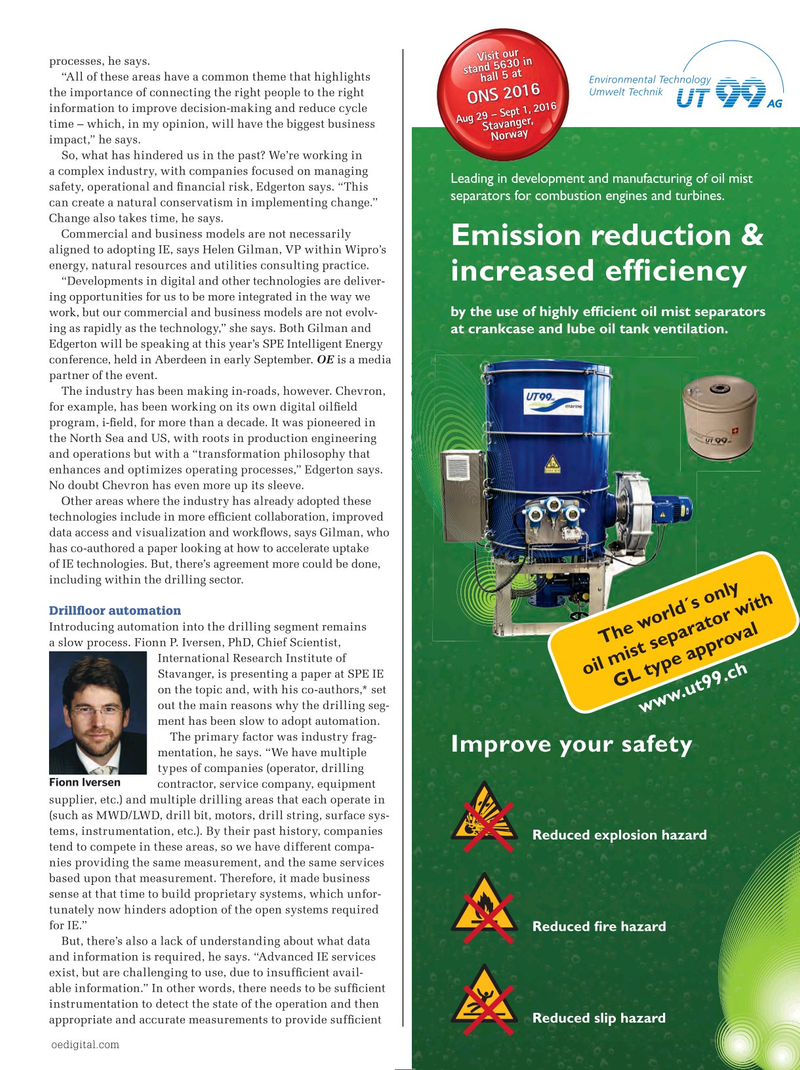
Page 53: of Offshore Engineer Magazine (Aug/Sep 2016)
Read this page in Pdf, Flash or Html5 edition of Aug/Sep 2016 Offshore Engineer Magazine
Visit our processes, he says. stand 5630 in “All of these areas have a common theme that highlights hall 5 at the importance of connecting the right people to the right
ONS 2016 information to improve decision-making and reduce cycle
Aug 29 - Sept 1, 2016 time – which, in my opinion, will have the biggest business
Stavanger,
Norway impact,” he says.
So, what has hindered us in the past? We’re working in a complex industry, with companies focused on managing
Leading in development and manufacturing of oil mist safety, operational and ? nancial risk, Edgerton says. “This separators for combustion engines and turbines.
can create a natural conservatism in implementing change.”
Change also takes time, he says.
Commercial and business models are not necessarily
Emission reduction & aligned to adopting IE, says Helen Gilman, VP within Wipro’s energy, natural resources and utilities consulting practice. increased effciency “Developments in digital and other technologies are deliver- ing opportunities for us to be more integrated in the way we by the use of highly effcient oil mist separators work, but our commercial and business models are not evolv- ing as rapidly as the technology,” she says. Both Gilman and at crankcase and lube oil tank ventilation.
Edgerton will be speaking at this year’s SPE Intelligent Energy conference, held in Aberdeen in early September. OE is a media partner of the event.
The industry has been making in-roads, however. Chevron, for example, has been working on its own digital oil? eld program, i-? eld, for more than a decade. It was pioneered in the North Sea and US, with roots in production engineering and operations but with a “transformation philosophy that enhances and optimizes operating processes,” Edgerton says.
No doubt Chevron has even more up its sleeve.
Other areas where the industry has already adopted these technologies include in more ef? cient collaboration, improved data access and visualization and work? ows, says Gilman, who has co-authored a paper looking at how to accelerate uptake of IE technologies. But, there’s agreement more could be done, including within the drilling sector.
Drill? oor automation
Introducing automation into the drilling segment remains
The world´s only a slow process. Fionn P. Iversen, PhD, Chief Scientist,
International Research Institute of oil mist separator with
Stavanger, is presenting a paper at SPE IE
GL type approval on the topic and, with his co-authors,* set out the main reasons why the drilling seg- www.ut99.ch ment has been slow to adopt automation.
The primary factor was industry frag-
Improve your safety mentation, he says. “We have multiple types of companies (operator, drilling
Fionn Iversen contractor, service company, equipment supplier, etc.) and multiple drilling areas that each operate in (such as MWD/LWD, drill bit, motors, drill string, surface sys- tems, instrumentation, etc.). By their past history, companies
Reduced explosion hazard tend to compete in these areas, so we have different compa- nies providing the same measurement, and the same services based upon that measurement. Therefore, it made business sense at that time to build proprietary systems, which unfor- tunately now hinders adoption of the open systems required for IE.”
Reduced fre hazard
But, there’s also a lack of understanding about what data and information is required, he says. “Advanced IE services exist, but are challenging to use, due to insuf? cient avail- able information.” In other words, there needs to be suf? cient instrumentation to detect the state of the operation and then
Reduced slip hazard appropriate and accurate measurements to provide suf? cient oedigital.com 054_OE0816_Production1_SPE IE.indd 55 7/25/16 11:06 AM

 52
52

 54
54